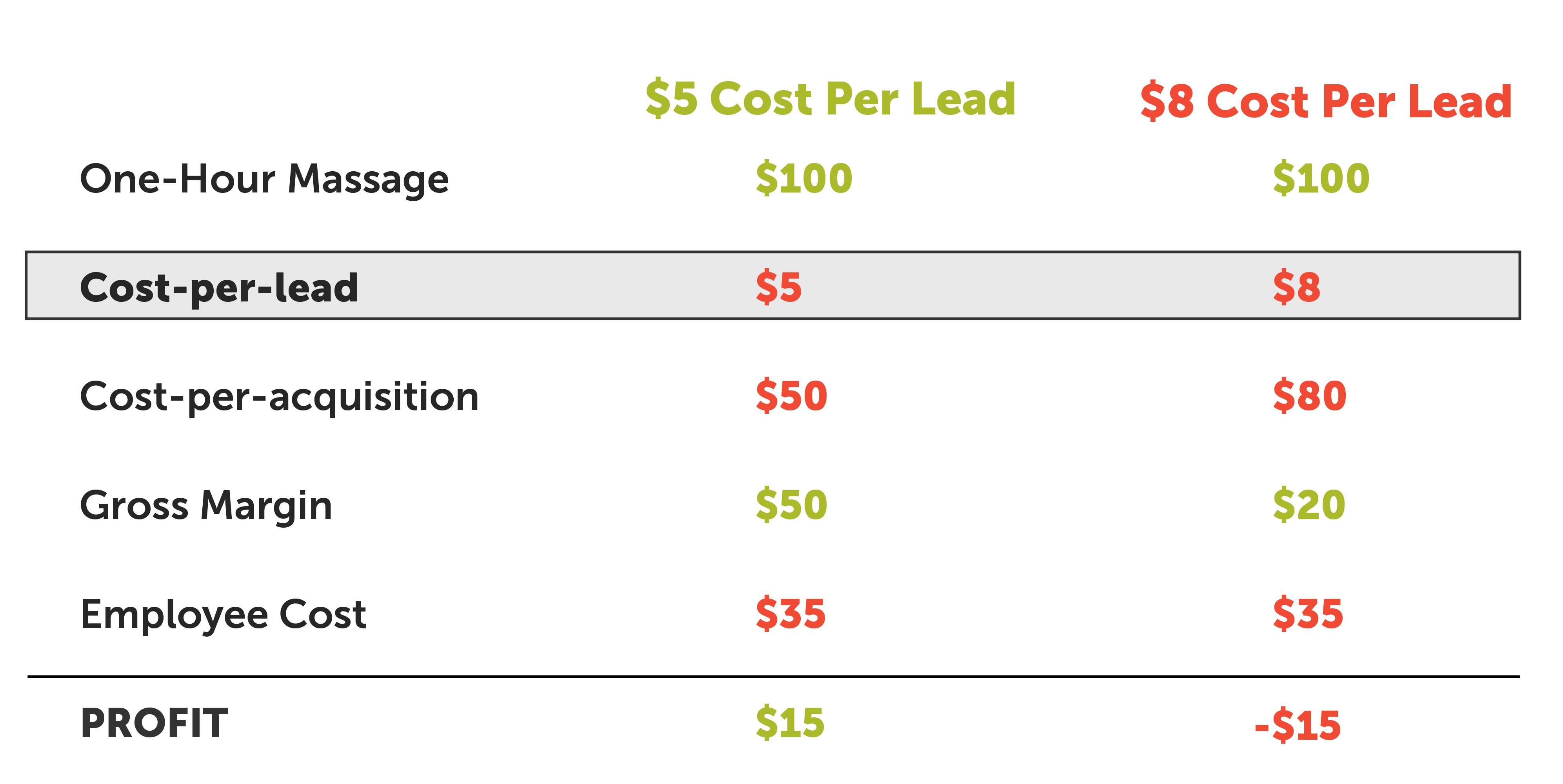For years, you’ve seen fellow businesses get amazing results from PPC campaigns. Finally, you have the time and the budget, so you decide to take the leap and hire an agency to help with AdWords management or other PPC ads. Each month, you wait with bated breath for your results, hoping to see lots of leads and a low cost-per-lead (CPL).
Yet month after month, you open the report….and your heart sinks. The numbers just aren’t where they need to be, and your patience is dwindling.
Before you freak out or have a tough talk with your PPC partner, take a deep breath and consider these tips for how to move forward.
What does poor performance look like?
If you sign in to your PPC account or look at your monthly report and see a low number of clicks or impressions, your first thought might be that the campaign is doing poorly. However, those numbers are just vanity metrics. What’s more important is the quality of those clicks, number of conversions, cost-per-lead (CPL), and cost-per-acquisition (CPA).
Imagine if you ran a pool maintenance company that uses PPC to drive leads, and you notice that your ads are getting hundreds of clicks for the keyword “install new pool pump.” Lots of clicks is a good thing, right? The problem is that you don’t install pool pumps, so once people arrive on your site, they realize you don’t have what they’re looking for and leave.
On the other hand, let’s say your AdWords management agency adds negative keywords related to installation. After a few weeks you see the number of clicks dip, and once again, you worry the campaign is in trouble.
But when you look closer at the numbers, you realize you’re getting the same number of inquiries for a lower budget. Plus, the leads are all people who are looking for exactly what you offer, so they’re more likely to sign up to work with you. Although the number of clicks decreased, the more important metrics — lead quality, CPL, and CPA — all got better. What initially seemed like a poor performance actually turned out to be good!

In addition to the number of leads or conversions, cost-per-lead (CPL) is another metric that gauges performance. It’s not quite as simple as shooting for a low CPL, though. The best way to evaluate whether your CPL is good or bad is to compare it to the cost of your product or service.
Let’s say you own a massage therapy business. The cost of a one-hour massage is $100, your cost-per lead is $5, and 10% of the leads you get from your PPC campaign convert into paying customers. That means the cost-per-acquisition is $50, and your business makes $50 in gross margin.
If it costs $35 to pay a massage therapist to deliver the service, your profit would be 15%.
On the other hand, consider if your cost-per-lead jumped to $8. If the massage cost and conversion rate stay the same, your cost-per-acquisition will increase to $80, leaving $20 in gross margin. Although a $3 increase may not seem like a lot, it takes a big chunk out of your margins, which means there’s room for improvement in your PPC campaign.
If it still costs $35 for the massage therapist to give the massage, you’d actually be losing $15 on each sale.

Doing your own AdWords management? Here’s when it’s time to get help.
So far, we’ve assumed that you’re already working with a PPC agency who can diagnose what’s causing poor performance and find a solution. If you’re managing your own campaigns, there are still some steps you can take on your own, such as:
- Ensuring you’re targeting the right people
- Refining your keyword lists regularly to pause poor-performing keywords and add new ones
- A/B testing ad copy, design, extensions, etc.
However, self-management takes at least a couple of hours each week, so if you don’t have time to keep up with PPC changes and manage your accounts, outsourcing may be more efficient and effective. (Check out this article for more tips on how to evaluate whether hiring a PPC partner is worth it.)
Already have an agency? Here’s when it’s time to be concerned.
If the agency has been working on your campaigns for less than six months, be patient and give them time. It takes at least 60-90 days to establish benchmarks, and then several months to see the results of refinements and optimizations. However, if you’ve set specific, realistic goals and your PPC company isn’t meeting them within 6-12 months, it may be time to start looking for a new partner.
Keep in mind: The first company that launches your PPC campaigns is usually at a disadvantage because they don’t have historic data to work with. Give the campaigns time to collect data, or consider having another PPC expert give them a closer look before making any big changes or switching agencies.
What should you do?
Even if your campaigns aren’t doing as well as you hoped, the good news is that you don’t have to do much to improve their performance when you have a team of AdWords management professionals by your side. Small dips and seasonal changes are normal, and both will be noted by your agency partner.
Within a week or two of the campaign launch, your PPC team should have an idea of how things are progressing. Our team at ParaCore has monthly reporting calls with our clients, where we discuss the results from the past month and optimization plans for the next month. If you have concerns about campaign performance, this is the perfect time to speak up so we can address those concerns and make course corrections if needed.
That being said, one of the other big reasons campaigns struggle is because they don’t have engaging, downloadable content or other offers that make people want to convert or share their contact information. Without these assets, even the best campaign can fall short. If your campaign isn’t performing, talk to your PPC manager about potentially changing the offer or developing a new piece of valuable content that would act as a magnet for leads.
What should your PPC partner do?
Step 1: Establish whether or not there’s a real problem.
As you saw earlier, sometimes poor performance can masquerade as good performance and vice versa. Clicks aren’t a clear indicator of how a campaign is performing, so it’s important to the quality of those clicks, whether they generate good leads, and how much gross margin they leave you.
Step 2: Diagnose the problem.
Things in the digital marketing world change monthly, weekly, even daily. Competitors might start targeting your keywords and drive the cost up, an algorithm might be tweaked, or an ad format might change. These shifts may affect your campaign success, but because they aren’t always obvious and multiple changes often happen at the same time, diagnosing the problem is the first big step in figuring out how to solve it.
When our team approaches this type of situation, we start playing doctor and asking questions like these to hone in on the main “illness”:
- Does the landing page have the right messaging?
- Is the ad copy memorable?
- Is there a technical problem?
- Are the phone numbers click to call?
- Is the bid too low?
Step 3: Prescribe a solution.
Once we’ve narrowed down the problem, the real work begins. The exact “cure” will depend on the issue at hand, but no matter what, it’s best to make one change at a time, then give that change time to take effect before making another one.

These types of optimizations are part of monthly AdWords management and PPC optimization. However, if minor changes don’t make an impact after a few weeks or months, or if there have been other shifts in your business that affect your digital strategy, it may be time for a more in-depth campaign overhaul.
Whether you’re a DIY-er who’s considering hiring an agency or a client that’s worried about the campaigns your current PPC agency is running, we’re here to help. Sign up for a free consultation to tell us more about your concerns and get suggestions on how to solve them.
Related Posts
- What Is The Difference Between PPC and SEM?
- PC Audit Handbook: How to Analyze Your PPC Campaigns
- The Best PPC Tools of 2022, As Told by PPC Experts
- Beginner’s Guide to UTM Tags & Tracking
- Generate Leads with Facebook Lead Ads
- Cost-per-click vs. cost-per-acquisition: Are you tracking the right PPC metrics?
- How Does Pay Per Click Work?
- Benefits of PPC
- Why Should I Invest in PPC?
- What is Google PPC Advertising?
- Facebook Retargeting Strategy
- Introduction to ManyChat
- Case Study: Return on Ad Spend Optimization
- 🎁🎄 Holiday Ad Spend Strategy
- Should You Be Running Branded Ads?
- SEO vs SEM
- CTAs for YouTube Ads
- Case Study: 258% Increase in Conversions
- Traffic Campaign Strategy
- No Captions on Facebook Ads or YouTube? You’re Killing Performance
- LinkedIn InMail Website Re-targeting




